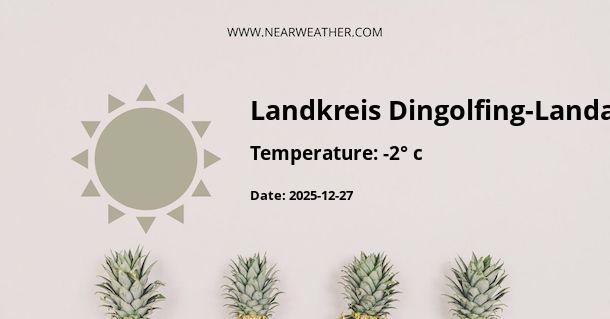Understanding the Climate and Weather Patterns of Landkreis Dingolfing-Landau, Germany
Located in the heart of Bavaria, the Landkreis Dingolfing-Landau is a district known for its dynamic weather patterns and rich cultural heritage. Examining the climate of this region requires understanding the overarching climate influences acting upon Southern Germany and the particularities that define the weather experienced by its residents year-round.
Geographical and Climatic Influences
The region can be characterized by its continental-climate tendencies, encompassing warm summers and cold winters. However, its transitional position between the oceanic weather of the west and continental influences from the east means that the weather can exhibit significant fluctuations. Below, we present some of the climatic features relevant to Landkreis Dingolfing-Landau:
- Average Temperature: Monthly average temperatures fluctuate from lows of -2°C (28°F) during the winter months to highs of 24°C (75°F) or more in the peak of summer.
- Precipitation: The area receives a moderate amount of precipitation year-round, with heightened activity usually in the late spring and throughout summer.
- Wind: The district is subject to varying wind currents, primarily affected by the frontal systems moving across Europe.
Seasonal Weather Patterns
The four distinct seasons in Landkreis Dingolfing-Landau each bring their unique weather patterns:
Spring: Beginning in March, temperatures gradually rise, and the snow from winter starts to melt away, making room for flowering landscapes. Precipitation increases towards the end of the season, leading to verdant and lush surroundings.
Summer: Summers are moderately warm with occasional hot periods. Rainfall peaks during summer, often manifesting as thunderstorms due to warmer atmospheric conditions conducive to convective precipitation activity.
Fall: Fall ushers in cooler temperatures and a scenic display of foliage. The weather during this season is known for its volatility, transitioning from warm early autumn days to cooler, crisper conditions leading into winter.
Winter: Winters are generally cold with a high likelihood for snow, particularly in January and February. Freezing temperatures are standard, and frost is a common occurrence.
A Closer Look at Weather Statistics
Let's delve deeper into the climate statistics to give you a more thorough idea of what to expect in this Bavarian region.
Temperature and Precipitation
The following table presents an overview of average high and low temperatures, as well as average precipitation levels for Landkreis Dingolfing-Landau:
| Month | Average High (°C) | Average Low (°C) | Precipitation (mm) |
|---|---|---|---|
| January | 2 | -2 | 47 |
| February | 4 | -1 | 43 |
| March | 8 | 1 | 51 |
| April | 14 | 4 | 57 |
| May | 18 | 8 | 87 |
| June | 22 | 12 | 96 |
| July | 24 | 13 | 104 |
| August | 24 | 13 | 99 |
| September | 18 | 9 | 66 |
| October | 13 | 5 | 59 |
| November | 7 | 2 | 52 |
| December | 3 | -1 | 59 |
Seasonal Weather Conditions
Expanding on seasonal data, we can illustrate how weather conditions in Landkreis Dingolfing-Landau modulate. The district experiences roughly 1800 hours of sunshine per year, with those numbers increasing during the summer months. At the same time, winter months are typified by less sunlight due to the region's latitude, and often overcast skies.
Extreme Weather Events
While extreme weather is not as common in Landkreis Dingolfing-Landau as in other parts of the world, the district is not immune to them. Instances of heavy snowfall can lead to disruptions in winter, and summer months occasionally see severe thunderstorms that can result in flash-flooding and hail.
Climate Change Impact
Climate change projections indicate that regions like Landkreis Dingolfing-Landau could experience a rise in average temperatures and an increase in the frequency of extreme weather events. Long-term data trends show that the district's climate is gradually warming. This warming trend is expected to influence the length and intensity of seasons, as well as precipitation patterns.
Environmental Considerations
An understanding of the local climate is vital for agricultural practices, urban planning, and managing natural resources. Careful consideration of weather data can help mitigate potential adverse effects of climate change and support sustainable development in the district.
Summary & Practical Information
As someone interested in the weather patterns of Landkreis Dingolfing-Landau, it's beneficial to comprehend the intricacies of its transitional climate. Those looking to visit or live in the area should be prepared for a range of weather conditions and plan accordingly.
For residents, it's advisable to have a wardrobe that can adapt to frequently changing weather conditions and to be aware of the potential for extreme weather events, particularly in winter and summer. Visitors should check local weather reports and advisories before traveling to ensure they have the most current information on weather conditions for the area.
Conclusively, Landkreis Dingolfing-Landau's climate reflects a harmonious blend of continental and oceanic influences that shape its distinct seasonal patterns. Recognizing the nuances of this region's weather is essential for adapting to and appreciating the rhythms of life in this picturesque part of Bavaria.
A - Landkreis Dingolfing-Landau's Latitude is 48.650280 & Longitude is 12.609440.
A - Weather in Landkreis Dingolfing-Landau is 13° today.
A - Climate Conditions in Landkreis Dingolfing-Landau shows broken clouds today.
A - Humidity in Landkreis Dingolfing-Landau is 80% today.
A - Wind speed in Landkreis Dingolfing-Landau is 3.92 km/h, flowing at 49° wind direction. today.
